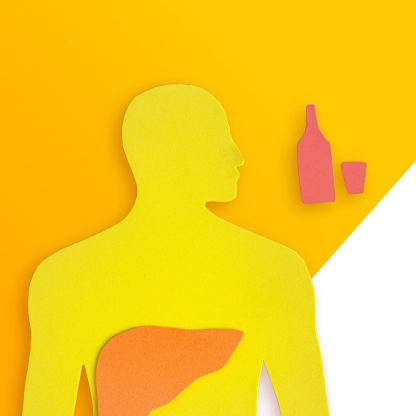
Article summary
Topic
Until recently, liver diseases were mainly thought to be associated with excessive alcohol intake or viral inflammation of this organ. Alcohol still remains an important problem that causes considerable damage to this organ but studies have begun to shed a new light on also other factors that are associated with an unhealthy lifestyle. Therefore, a new disease has been defined and classified as a disease of affluence – non-alcoholic fatty liver disease. It is also often referred to by its abbreviation NAFLD and refers to fattening of the liver that results from other causes than alcohol-related.
It is estimated that already every fourth adult person may be affected by that disease. On the global scale, as much as one billion people are estimated to live with NAFLD!1
Alcohol remains a serious problem causing significant damage to this organ
What are the causes of NAFLD?
Although NAFLD is already classified as a disease of affluence and is generally recognised as a serious health hazard, its relationship to metabolic dysfunctions remains largely unknown. An international scientific panel has recently suggested a change of the disease name from “non-alcoholic fatty liver disease” (NAFLD) to “metabolic-associated fatty liver disease” (MAFLD), so as to reflect better the metabolic background of this disorder.2
Research studies on factors that cause NAFLD are still on-going but it is already known that they can be divided into genetic and external ones. The best known risk factors for NAFLD are:
What are the symptoms of NAFLD?
The symptoms usually associated with non-alcoholic fatty liver disease are:
weakness, fatigue
malaise
sleep disorders
attention deficit
lack of appetite
pain in the right subcostal region6
Accelerate liver regeneration with Phospholipids (Essentiale® Forte P)
How is NAFLD diagnosed?
NAFLD is diagnosed on the basis of a clinical interview, laboratory test results and imaging examinations. A confirmation of diagnosis is the result of a histological examination – liver biopsy.1 In the diagnostic work-up, it is very important to rule out other causes of fatty liver such as excessive alcohol consumption and other chronic diseases of the liver.7
In the assessment of advancement of hepatic tissue fibrosis in the course of NAFLD, it can be helpful to use certain non-invasive diagnostic tests, e.g. the NFS that analyses 6 factors: age, BMI, laboratory test results: blood glucose, AST and ALT, blood platelet count, albumin level.1,7
How is NAFLD treated?
The first line of treatment usually includes:
How to prevent NAFLD?
In NAFLD prevention you should concentrate mainly on having a healthy lifestyle and eating habits:
FAQ
- simple fatty liver disease (NAFLD)
- non-alcoholic steatohepatitis (NASH)
- hepatic cirrhosis
The following 3 disease stages are distinguished:7
It is our lifestyle that is largely responsible for the development of NAFLD. By changing dietary habits and increasing physical activity, which translates into weight loss, you can positively influence the condition of your liver. Reduced fat content in the liver as a result of physical activity has been demonstrated. It has also been evidenced that weight loss has a positive effect on aminotransferase levels in laboratory tests, and a >10% weight loss in most patients leads to a remission (reversal) of NAFLD.3
- Perumpail, B. J., Khan, M. A., Yoo, E. R., Cholankeril, G., Kim, D., & Ahmed, A. (2017). Clinical epidemiology and disease burden of nonalcoholic fatty liver disease. World Journal of Gastroenterology, 23(47), 8263–8276
- Shiha, G. et al. Redefining fatty liver disease: an international patient perspective. The Lancet Gastroenterology & Hepatology; VOL 6, ISSUE 1, P73-79, JANUARY 01, 2021
- Gietka J. Klapaczyński J., Stłuszczenie wątroby - diagnostyka i leczenie, https://podyplomie.pl/medycyna/23439,stluszczenie-watroby-diagnostyka-i-leczenie, accessed on: 29/03/2019.
- Gruben N., Shiri-Sverdlov R., P.Y. Koonen D., Hofker M.H., Nonalcoholic fatty liver disease: A main driver of insulin resistance or a dangerous liaison? https://www.sciencedirect.com/science/article/pii/S0925443914002579?via%3Dihub accessed on: 09/02/2021
- Gavril et al. Relationship between NAFLD and hypertension in patients with type 2 diabetes mellitus; J Hypertens Res (2017) 3(2):44–49
- Sterczyński R. Leczenie niealkoholowej stłuszczeniowej choroby wątroby: kluczowa jest zmiana diety Puls Medycyny https://pulsmedycyny.pl/leczenie-niealkoholowej-stluszczeniowej-choroby-watroby-kluczowa-jest-zmiana-diety-982340 accessed on: 12/05/2021
- Strzeszyński Ł. Rozpoznawanie i leczenie niealkoholowej stłuszczeniowej choroby wątroby; Medycyna Praktyczna Gastrologia www.mp.pl/gastrologia/wytyczne/80328,rozpoznawanie-i-leczenie-niealkoholowej-stluszczeniowej-choroby-watroby accessed on: 12/05/2021
%20(1)%20(1).webp)

